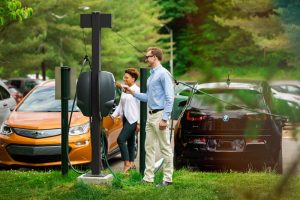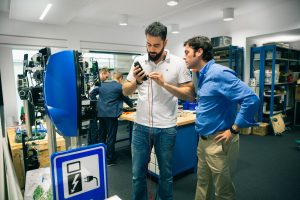
Category
Hardware, B2B

Written by
Ethan Garr & Sean Ellis
Customer Advocacy Powers Sustainable Growth for EVBox
EVBox is an extraordinarily fast-growing manufacturer of electric vehicle charging station solutions. It is a hardware company that is winning in an exploding market that expects to see 100 million electric vehicles (EV’s) on the roads in 2030, from just over 7 million cars in 2020. But winning the market is not EVBox’s focus, what they really want to do is to lead the industry.
extraordinarily fast-growing manufacturer of electric vehicle charging station solutions. It is a hardware company that is winning in an exploding market that expects to see 100 million electric vehicles (EV’s) on the roads in 2030, from just over 7 million cars in 2020. But winning the market is not EVBox’s focus, what they really want to do is to lead the industry.
On the surface, this distinction between market leader and industry leader may seem inconsequential. However, as we dive into the EVBox growth story, we will learn how the company’s mission to drive sustainable mobility and a zero-emission world does require a mindset and leadership that looks beyond simply gaining market share to instead developing the industry and building mindshare around EV adoption.
In this growth study, we will look at how the company transitioned into this mindset, and how it emphasizes and prioritizes advocacy, retention, and delighting the customer over beating the competition. We will then find out why that has become a key factor in maintaining EVBox’s startup culture and enthusiasm even through the company’s 2017 acquisition by ENGIE, one of the world’s largest energy companies.
If you are not in a hardware-based business, you may be thinking that the EVBox growth story is likely very disconnected from your own journey, but as we dig deeper we think you will find many actionable lessons that can be applied across industries and disciplines. Let’s jump in and explore EVBox to learn:
– How they have engaged with customers to unlock their addressable market
– The challenges they have faced tuning product/market fit
– Their approach to leading teams through explosive growth
– How advocacy plays an important role in their growth process
– The lessons and learning of their Covid-19 experience
Explosive Growth in a Growing Market
Hugo Pereira, the Chief Growth Officer of EVBox, began his tenure in 2015 when the company had just 10 employees; today they have more than 700. This growth mirrors the shift towards electric mobility that has accelerated at a breakneck pace since those early days when it was relatively rare to see a Tesla or other EV on the road. The explosive growth of this market has necessitated a new infrastructure to support electric mobility, and EVBox’s charging stations and related software and services play an important role in this evolving landscape.
when the company had just 10 employees; today they have more than 700. This growth mirrors the shift towards electric mobility that has accelerated at a breakneck pace since those early days when it was relatively rare to see a Tesla or other EV on the road. The explosive growth of this market has necessitated a new infrastructure to support electric mobility, and EVBox’s charging stations and related software and services play an important role in this evolving landscape.
Originally, the company had a B2C model, but today they primarily focus on B2B2C. Since many early adopters of EVs were likely looking at their EV as a second car for shorter trips and commutes, focusing on putting charging stations in consumer garages was probably a good starting point, but now the future looks like a world where EVs could replace internal-combustion engines altogether. By shifting its focus to B2B, EVBox better positioned itself to impact the industry and forward its mission.
If EV’s are the key to the zero-emission world the company envisions, then building the industry means facilitating the integration of charging stations everywhere we drive. Moving beyond consumer sales to a broader focus on automotive manufactures, utility and energy companies, fuel suppliers, hotels, workplace facilities, and others means that EVBox can influence and lead the industry as the market it serves grows to 100 million vehicles over the next 10 years.
Hugo and his team are passionate about making a difference. He explains that 91% of humans are breathing polluted air, and he believes the growth of the EV industry can help solve that problem. Fortunately, the 2017 acquisition of EVBox by ENGIE, the multinational electric utility company ENGIE has worked to support these gigantic ambitions. Hugo explains that EVBox continues to run independently, but with more tools and access to the large organizations ENGIE has relationships with around the world:
We could start [making] investments in order to build specific products or solutions or to increase the teams and the footprint . . . We could keep the culture and entrepreneurial spirit, and that helped us a lot. So definitely it was a turning point when [ENGIE acquired EVBox]. It allows us to actually start investing more and to be able to get the right data, to support our growth, which before we couldn’t do, because we were playing very much on the job and with the financial business model we had.
That commitment to preserving the entrepreneurial culture has been a key part of the EVBox story; people, powered by purpose to build the right products has been at the core of the company’s success. In the comings sections, we will dig into the leadership and process that have kept this passion in focus not only through the ENGIE acquisition but throughout the company’s breakout growth journey. First, we will look to understand the challenges of dialing in product/market fit as a hardware company in a changing and expanding market.
Product/Market Fit: “We Have to get it right, not get it fast”
Although EVBox’s growth has been meteoric, it has not been linear. While the company has seen some years with more than 100% growth, it has also had years with a more earth-bound 20 – 30% growth rate. Of course, most companies would be thrilled to achieve even these lower bands of growth, but there are valuable learnings in the “why” behind this inconsistency. Hugo suggests that two key factors have impacted the growth trajectory; both speak to the challenges of dialing in product/market fit as a company grows:

First, the pivot from B2C to B2B2C proved more challenging than expected. The shift involved more than just a change in messaging and positioning, but a change in thinking as well. Hugo explains that they had to re-focus the entire acquisition approach, experiments, website, sales intake, and the organization to say, “we’re going to focus on business first to go after large businesses and build the right network of resellers.”
Essentially, the company moved from a successful model where consumers looking for charging stations for their homes could directly purchase solutions, to a new model where companies would have to recognize EVBox’s value as a provider of whole-business charging solutions. Commercial buyers had different problems to solve, and finding product/market fit was a challenging process of adapting the EVBox solution-set to meet the needs of this market.
The second factor that caused uneven growth for EVBox was its international expansion efforts, which brought new product/market fit challenges as each localized market proved nuanced and unique. As we have studied breakout growth companies, we have found that this is not at all unusual.
For another perspective on the hurdles companies face in dialing-in product-market fit through international expansion, take a listen to our Breakout Growth Podcast interview with Global Co-CEO of Finder, Fred Schebesta.
Hugo further explains, “We were expanding to seven countries and to seven offices selling to 30 to 40 countries with resellers. You know, sometimes expanding also can slow down the operations.” The team learned that this expansion into other countries was not linear and brought specific challenges such as varying timelines for hardware certification. In the US, for example, the equipment certification process took more than a year. The main issue, however, is that each market was different and had different needs. Finding product/market fit meant not just learning and addressing those needs, but developing processes to support that learning.
However, even as EVBox was tested by these challenges, their underlying hunger for growth was being fueled by their larger mission. The motivation and enthusiasm for growing through the pivot to B2B2C and through their international expansion was driven by the overarching goal to become an industry leader. Fortunately, the EVBox team was also discovering a secret weapon in overcoming these and other challenges common to fast-growing companies.
A growth engine powered by customer advocacy
 As a B2B2C company, EVBox faces interesting challenges as it looks to power a sustainable growth engine. Very often the people who buy EVBox’s charging solutions are not EV drivers themselves. A hotel facility manager, for example, might consider purchasing a charging solution to attract a new cohort of EV-driving guests even though she herself does not drive an EV. It is therefore difficult for her to experience or even fully understand the value ahead of the purchase. For this reason, even though the buying process often begins with search or paid ads, building trust through referral and word-of-mouth influences can ultimately be an important part of the buying decision.
As a B2B2C company, EVBox faces interesting challenges as it looks to power a sustainable growth engine. Very often the people who buy EVBox’s charging solutions are not EV drivers themselves. A hotel facility manager, for example, might consider purchasing a charging solution to attract a new cohort of EV-driving guests even though she herself does not drive an EV. It is therefore difficult for her to experience or even fully understand the value ahead of the purchase. For this reason, even though the buying process often begins with search or paid ads, building trust through referral and word-of-mouth influences can ultimately be an important part of the buying decision.
This is an area where Hugo sees the value of EVBox’s intense focus on customer advocacy. While the company doesn’t directly interact with end consumers the way it did before pivoting to its B2B2C model, it does take an active role in advocating for both customers and drivers by equipping resellers with content, case studies, and other collateral and by actively building and participating in the EV community.
Commercial buyers often have relationships with fleet managers, parking lot managers, and other potential buyers, so closing the loops between stakeholders can have a significant impact in driving interest, awareness, and trust in the company’s solutions.

In addition, the company uses testimonials, videos, and in-office demonstrations to help potential buyers understand the value these charging stations can deliver for businesses and consumers. Hugo explains that video is especially important in helping prospects visualize the aha moments prior to purchasing a solution.
The marketing team also actively works to build the EV community by hosting, attending, and presenting at events. As potential customers are identified through these acquisition efforts, the sales and activation process can then focus on setting up live demos and showcasing value in person where possible. Once a customer has made the purchase decision, EVBox nurtures the ongoing relationships by helping customers understand the value they are getting from the product. This is where the focus on customer advocacy can then work to drive customer delight and further accelerate growth cycles.
Leading explosive growth as an industry leader
To manage the company’s expansion EVBox has built an organizational structure that fosters a culture where everyone plays a role in growth. The growth team itself is now 56 people strong, but Hugo feels that “Everyone [in the organization] has to be empowered to experiment and to have the scope to suggest something . . . to be off the books or to be a bit off the process, just to see what can work better.”
This mindset seems to be an important factor in helping to strike the balance between growth and bureaucratic control. Hugo says the company has been able to maintain the startup culture even as they onboard 30-50 new employees each month, but it has required a change in organizational mindset. Originally when the company was small and everyone could sit together in a room to solve problems, profit and product were the priority, but over time people have become the focus. He explains that since 2017-18 that evolution has resulted in a culture where people powered by purpose build the right products and then revenue, profit, and growth follow:
Now we cannot afford to have everything trying to be solved by everyone. So, of course, we need to rely more on the people that we bring in to really make a difference…we just have to accept that it’s more about the delegation of trust and having the empowerment. That’s the team leaders, the leadership, and the new people that join the organization, having the liberty to help you grow.
Hugo’s team is substantially subdivided to meet the tremendous demands of fast-paced growth. The growth department includes a strategy team responsible for developing the industry and a policy team. It may seem odd to have a policy team under growth, but in the rapidly changing EV industry policy plays an important, and fast-changing role. Staying ahead of policy evolution in hardware is therefore very relevant in the growth process. The marketing-growth team is then its own unit within the growth organization, and it is led by its own head of marketing-growth. This team includes:
– Brand Experience – Content studio, brand advocacy and experience, PR, comms, and events, social media and corporate communications
– Acquisition – design, development, experiments, advertising
– Product-Marketing – product DNA, value proposition development, value-based pricing, competitive analysis
– Channel-Marketing – resellers, partners, partner marketing, account-based marketing, training and support
– International Marketing – localized marketing by country
– Policy – public affairs, lobbying on specific policies, advocacy
– Go-To-Market Strategy – product-market fit, long-term strategy, industry trends
Hugo explains that the marketing-growth team has to be highly collaborative across the organization. As examples, he describes how his team works closely with sales and product. With the sales team, they have to ensure that the value proposition fits with what customers are demanding, and with the product team they must ensure that product development and operations are coordinated so that products are launched on time and with the right assets.
With so many moving parts, it is clearly a challenge to keep teams aligned and focused, but Hugo is quick to point out that leadership is very intentional in its efforts to keep everyone informed and involved as to where the company is going, and to make sure the mission is always in focus. He explains that sometimes this means slowing things down:
Sometimes it comes down to understanding that we are going to keep being a fast organization, but we have to start getting things more often right then getting things fast. And I think that is a bit of a change from before where we’re very much focused on ‘let’s get things fast’ and many times we would not be getting those things right.
He points out that the company uses “Connected Charging Ports” as its North Star Metric (NSM), which has helped teams align and focus on the mission. This gives everyone a clear understanding of how each individual and team effort connects to the larger idea of becoming an industry leader on the way to sustainable mobility and a zero-emissions world.
A sustainable future with the customer in focus

“I think there’s only one question in my mind these days: How easy is it towork with us?” This is the frame from which Hugo looks at EVBox and sees its future at the forefront of the EV revolution. For him, it all comes down to a passion for customer advocacy as the foundation of long-term, sustainable growth. “Competitors can copy hardware and software, but not the customer relationship,” he says emphatically.
Many companies run into their own headwinds as breakout growth takes shape. The traditional challenges of scaling rapidly can create silos, disconnect the rank and file from end-users, and reduce the quality of products and support. Ultimately, these problems can decelerate growth. However, EVBox has fought against this by putting people first. During the Covid-19 crisis, they have prioritized relationships over revenue to ensure that customers know that they have a partner they can trust. At the same time, helping their 600 employees navigate these difficult times has also been a priority.
“If customers trust us from before, and if we were reliable and transparent to them, then they stick with us because they know that these are only tough times. They also notice if we are being kind and caring towards them,” Hugo explains. This authenticity seems to unite the company with its customers and partners, and it also guides individuals and teams to continuously work to build EV into an exciting story of breakout growth.
Learn more about EVBox’s Breakout growth story in Sean Ellis’s Breakout Growth Podcast interview with Hugo Pereira here.
Photos courtesy of EVBox

